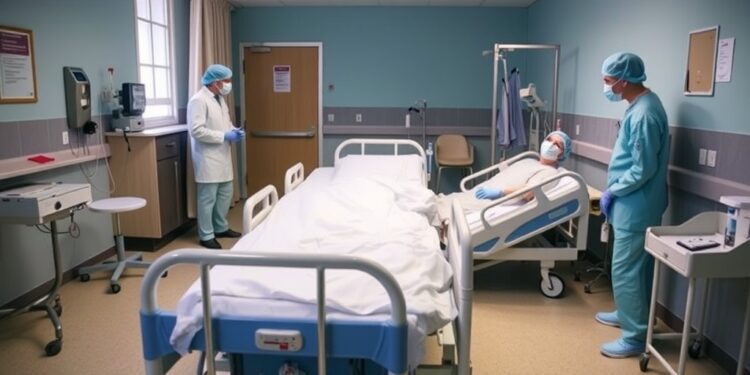
The United States is witnessing a significant shift in the dynamics of its healthcare system in the post-pandemic era. Recent studies have illuminated the troubling trends surrounding hospital occupancy rates across the nation. This newly established steady state of hospital occupancy is marked by an increase of 11 percentage points compared to pre-pandemic levels. Such a quantifiable rise is alarming, primarily as it has not been driven by a corresponding surge in hospitalizations but rather by a notable decrease in the availability of staffed hospital beds—down by 16%.
This situation evokes serious concerns among healthcare experts and policymakers. A critical warning has emerged from the study conducted by prominent researchers, indicating that the national hospital occupancy rate could dangerously approach 85% by the year 2032. The 85% occupancy threshold is considered a clear indicator of a potential hospital bed shortage, a condition that could severely compromise patient care and healthcare delivery.
The implications of reaching this occupancy rate are profound, signaling a potential crisis for the healthcare system. In a country like the United States, which is known for its advanced medical infrastructure, an increasing occupancy level could lead to a decline in the quality of care patients receive. This dilemma is compounded by the reality that healthcare facilities are experiencing a reduction in bed capacity, which ultimately threatens to overload hospitals during peak health crises or public health emergencies.
Geographic disparities further complicate this scenario. The risks associated with elevated hospital occupancy are not uniformly distributed across the nation. Certain states may face higher occupancy rates sooner than others, making it imperative for policymakers to devise state-specific strategies to mitigate these risks. Factors such as population density, regional healthcare policies, and the availability of healthcare resources contribute to these disparities.
Moreover, the ongoing reduction in staffed hospital beds has considerable roots in a variety of systemic factors. Financial strains resulting from operational losses during the pandemic, staffing shortages exacerbated by burnout, and a long-standing trend toward outpatient care have all played significant roles in decreasing hospital bed availability. Consequently, as the demand for healthcare services rises, the supply of available resources becomes increasingly diminished.
With the approaching healthcare crisis on the horizon, key stakeholders must engage in proactive discussions to address these looming challenges. Health systems must evaluate their resource allocations and capacity management strategies to prepare for a potential surge in required care. Innovations in telemedicine, outpatient service availability, and community health programs will play critical roles in alleviating pressure on hospital systems.
Additionally, a cultural shift towards preventative care can buffer the impending demand on hospitals. By prioritizing preventative measures and early intervention strategies, the pressure on hospital systems can be reduced, allowing for more manageable occupancy rates. Public awareness campaigns aimed at educating communities about health maintenance and available healthcare options will help mitigate unnecessary hospital visits.
As researchers delve deeper into these compelling findings, the urgency for comprehensive health care reform gains more traction. Future policy formulations need to incorporate flexible strategies that consider not only the immediate needs of hospital systems but also the long-term health of the population. The importance of preparing hospital infrastructures, through adaptable policies and financial mechanisms, cannot be overstated.
Furthermore, the ramifications of a persistent bed shortage extend beyond immediate patient care. They have broader implications for public health, including increased wait times for emergency services, pivotal delays in elective surgeries, and heightened pressure on healthcare professionals who are already navigating a challenging environment. Without targeted action, the repercussions of these trends could lead to dire consequences for both patients and healthcare workers.
To navigate these complex waters, collaboration across various sectors is vital. The integration of technology in healthcare, focusing on efficiency in operations, alongside a renewed commitment to workforce recruitment and retention, can pave the way for a more resilient healthcare system. Stakeholders must seize this moment to prioritize systemic reforms that enhance hospital capacity, reduce occupancy rates to safer levels, and ultimately protect the integrity of patient care.
As the healthcare domain evolves, the specter of an impending hospital occupancy crisis looms large. It is crucial for experts, leaders, and healthcare professionals to maintain dialogue around these findings, raise public awareness, and formulate actionable plans. Only through a concerted effort can the nation hope to avert a catastrophic outcome regarding hospital occupancy and maintain the viability of healthcare services in the years to come.
Subject of Research: Hospital occupancy rates and implications in the U.S. healthcare system post-pandemic.
Article Title: Study Reveals Alarming Hospital Occupancy Trends in Post-Pandemic America
News Publication Date: October 2023
Web References: N/A
References: N/A
Image Credits: N/A
Keywords: Hospital Occupancy, U.S. Healthcare, Post-Pandemic Trends, Hospital Beds, Healthcare Crisis
Tags: future of healthcare deliveryhealthcare policy challengeshealthcare staffing shortageshealthcare system crisishealthcare workforce issueshospital bed availability declinehospital occupancy ratesimplications of high hospital occupancymedical infrastructure challengesnational hospital bed deficitpatient care quality concernspost-pandemic healthcare trends





